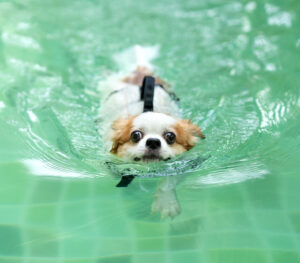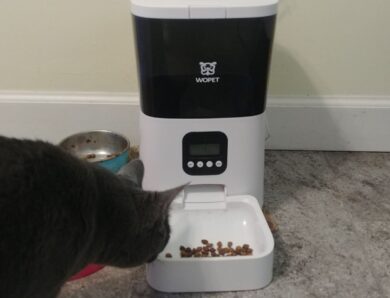
Dog Pool Safety Basics
For many dog owners, summer means opening up the backyard pool. Though the media is full of pups having a blast jumping into pools or splashing around in the shallow end, there are real risks for your fur baby the minute he’s around a pool.
Get to know these dog pool safety tips to ensure everyone has a happy, healthy summer hanging by the pool.
Know Your Dog
Not all dogs love the water. And even dogs that love the water aren’t always great swimmers.
Though there are exceptions, the heavier and more compact a dog is, the more difficulty that dog will have swimming and the more quickly he’ll tire out.
Breeds, including most retrievers and spaniels, Newfoundlands, and any breed with the term “water dog” in its name, are naturals. Others, including most small dogs with short legs (dachshunds, pugs, Pekingese), and dogs that tend to be heavy and squat (bulldogs, chows, basset hounds), can struggle mightily in the water.
If having a water-loving dog is important to you, research which breeds are best before getting a pup. If you already have a dog and you’re not sure, ask your vet for an opinion.
You also want to check before introducing an overweight or senior dog to swimming. All that paddling can put quite a strain on their heart and muscles.
If you’d prefer a doggie pool, check out our list of the five top-rated dog pools as rated by Amazon users.
Make Sure Your Dog Is Command Trained
One of the best ways to avoid a pool tragedy is to ensure your dog knows his basic commands: sit, stay, come.
Stay is perfect for preventing an overeager dog from diving in before anyone is ready for him or if there are small children in the pool who could get hurt by a cannonballing dog. The stay command is also good if you’ve gone to the beach and you’re heading out for a brief canoe or inner tube jaunt. If your dog isn’t coming, he’ll need to stay and wait on the beach for you to come back; you don’t want him trying to swim after you.
Come is needed for when you want the dog out of the water. For instance, if you notice he’s tiring out or is lapping the pool water you can have him come to enforce a rest or provide some fresh water.
Daily Foot Checks
During pool season, you’ll want to give your dog daily paw checks. Make sure the pads of their feet aren’t cracked or broken from running around the hard surface surrounding the pool.
Also keep an eye on their nails, which can get worn down by the concrete of the pool bottom and around the outside of your pool.
Keep a Float or Life Preserver on Hand
No matter how smart we like to think our four-legged best friend is, when a dog goes into panic mode it’s not thinking. A drowning dog — or one that thinks its drowning — will not understand it must relax in order for you to rescue it. Instead it will do everything in its power to climb on top of you.
That might not be a problem if you’re in thigh-deep water, but when you’re in over your head, a flailing dog is likely to get both of you killed.
Keep a float or a life preserver near the pool at all times. If your dog is struggling, throw it to him. He’ll grab it with his teeth or climb on top and then you can pull him out.
Get a Dog Life Jacket

Yes, they exist. They’re particularly invaluable for dogs that aren’t strong swimmers and any time you’re taking a dog out on the open water.
Even the best swimming dog can get tired or a sudden leg cramp. Life jackets ensure they can stay afloat if they suddenly can’t paddle.
Find out more about dog life jackets.
Introducing Your Dog to the Pool
While some dogs take to water like a duck, for others their first exposure can be scary. Always assume the latter and take it slowly.
Before taking the leap into the big pool, try a kiddie pool. Let him get his paws wet. Put your feet in too so he can see for himself when nothing bad happens.
For some dogs, particularly toy-sized dogs, this might be the biggest pool they ever get into. But for dogs that are ready to step up to the bigger pool, take it just as slowly.

Sloped Entries Are Best
Generally speaking, dogs have an easier time entering a pool that has a sloped entry. Not only is it more reassuring for a new-to-the-pool pup but it mimics the way dogs would naturally encounter water on their own.
For first-timers, you can treat a sloped entry the same as the kiddie pool. Enter the pool with him, get your feet wet. If he’s nervous, hold on tight to him so he knows you’ve got his back. However, don’t force him into the water. If he’s fighting your or trembling, step back. Go at his pace, not yours.
When he’s ready, go a little deeper. Let him paddle around, but keep a hold on him if you can.
Give him lots of encouragement and praise.
If you don’t have a sloped entry into the shallow end of your pool, consider getting a no-slip ramp. These typically lead from outside the pool into the water where they float on the surface, providing a more natural-feeling entry and exit point for your dog.
It might take a little training to get your pup to understand how to use the ramp and how it feels under his paws, but he’ll get the hang of it.
Remember, submerged stairs are notoriously hard for dogs to figure out. (And no dog is capable of climbing a pool ladder.)
Speaking of Stairs

If you don’t have a sloped entry and you’re not getting a ramp, you’ll need to spend some time training your dog to use the stairs. Dogs don’t have great depth perception so they often can’t tell which step to start with. Imagine trying to step on something that turns out to be further under water than you anticipated? You’d get freaked out, too.
Spend time with him in the pool having him practice. Place his feet on the top step and say “step.” You can even give him a treat when you say the word to give it a positive association. Let him get used to the feeling. If he seems comfortable, see if you can get him out into the water and let him swim back to the steps. Keep these lessons short and be encouraging throughout.
If you can, put some kind of marker near the stairs (potted plant, pool umbrella, a towel hanging on a pole). She’ll learn to associate the stairs with that object, so make sure it’s always there.
Again, the best option for dogs is to purchase a no-slip ramp and let your dog use that to get in and out of the water. As with the stairs, the ramp may take some training but, in the end, it’s easier for most dogs to use.
Watch for Fatigue
Anyone with children knows the cardinal rule of pool safety. Don’t take your eyes off of your kiddos. The same holds true with your dog. Keep an eye on her to make sure she’s not getting tired. The minute you think she’s starting to look heavy in the pool — her rear end will start lowering — call her out. She needs a rest.
Fresh Water
Fresh water is healthier for your dog than chlorinated pool water. Always keep fresh water on hand and if you see your pup drinking from the pool, call her over for fresh water.
Even if your dog is not one for lapping from the pool, you want to make sure she’s staying hydrated, especially if it’s a hot day.
Rinse Off After Swimming
After a swim, do your best to rinse your dog off to remove the pool chemicals, which can irritate her skin and fur. Chlorine can bother a dog’s eyes and nose, so give those spots extra attention. Be particularly diligent with rinsing your dog off if your pool is salt water. If he licks his fur before you’ve rinsed him off, he’s at risk for salt poisoning. Watch out for vomiting and diarrhea if he’s been in a salt water pool and take him to the vet at the first signs of illness.
When possible, give your pup a quick towel dry, especially in areas that can stay wet longer, like ears, groin and armpits. These are prone to moisture-based infections, but a quick dry can go a long way. We also recommend using a weekly ear cleaner if your dog is going to be spending a lot of time in the pool.
Beware Pool Covers
Pool covers are dangerous for dogs and toddlers. A tumble into a pool with a soft cover on it can easily lead to drowning for both. If you can, opt for a rigid pool cover that supports the weight of a full-grown person. If not, we highly encourage pool owners to put a fence around their pool.
Minus a fence or a rigid cover, it is imperative you never leave your dog (or a small child) unattended near a covered pool. What’s obvious to an adult human — don’t jump in a pool with a cover on — is no where near as obvious to a dog.





